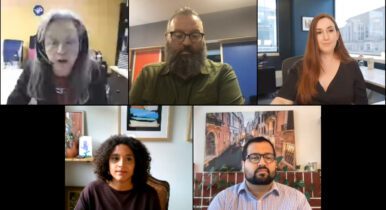Why Remote Shoots Are Here To Stay
The COVID-19 pandemic has dramatically shifted how digital video is produced. In this article, political consultant Germain McCarthy argues that many of those changes were for the better and they will likely carry over to next cycle and beyond.
When I studied video production in college, I obsessed over getting the perfect shot.
That used to mean traveling to a location, setting up tens of thousands of dollars worth of video equipment, and working up a sweat on set. Now, in the pandemic era, I’ve learned to do that all with a FedEx-ed DIY kit, an iPhone app, and a good WiFi connection.
Over the past six months, the pandemic has dramatically shifted how digital video is produced. But as we near the end of the cycle, some practitioners are wondering if the changes were for the better and if they’ll carry over to next cycle and beyond.
I think many of them will. Take remote testimonial shoots. These videos allow candidates to let their constituents speak for themselves — without the hassle and cost of a full production day. Mobile shoots also put more emphasis on direct-to-camera messaging due to the inability to shoot B-roll, and can be produced at a higher volume. Videos can then be distributed on platforms such as TikTok or Instagram, which reach busy voters on their phones.
Another reason these changes in video content will persist is because the way video is consumed has changed — starting with volume. Americans are consuming significantly more digital content since the coronavirus pandemic started, including a 43-percent increase in time spent on YouTube. And the content they’re consuming is different. Americans have quickly grown accustomed to videos shot not in a studio, but in a living room or a kitchen — oftentimes with a cat or a toddler running around in the background.
If political ads are going to break through amidst Americans’ busy lives right now, the ads have to meet the voters where they are — and in 2020 that’s socially distant sitting in their living room or kitchen.
As I directed videos in 2020 for our firm, I honed in on capturing that organic, shot-at-home feeling, more than the “perfect shot.” Overly produced ads will look out of place on a Facebook feed and make campaigns look out of touch.
The changes to the digital ad industry aren’t just driven by consumers: They’re also driven by the rapid shifts of pandemic-era video production. Fewer clients want to do in-person shoots, and the safety logistics make them extremely difficult.
The solution to this problem comes in a kit small enough to send overnight: an iPhone, ring light, and table tripod in a rugged Pelican case. Once the client gets the kit, they can set up their phone in their house and grant us access to use the camera during the shoot. This allows us to have digital control, and it allows the video subject to focus on the message and not adjusting the camera angle in a self-shot video. Or if they have an iPhone with high enough quality, we don’t even need to send them the kit.
From the production side, this innovation — which comes thanks to massive upgrades in iPhone camera quality over the past two years — gives us a lot more control to create high-quality, organic video content.
This also enables us to better tell the stories of real people whose lives are affected by policy decisions. This year, I’ve done remote shoots from a living room in rural Montana, a home office in St. Louis, Mo., and a kitchen in Green Bay, Wis. In an increasingly busy political environment, the voices of regular people often break through better than the candidates. Remote shooting enables us to get lots of these stories in high-quality, without the substantial expense of on-the-ground video shoots.
As I learned from shooting wedding videos and live events, the video quality goes up when the cameraman is as non-intrusive as possible. I’ve tried to blend in: being a fly on the wall, letting people live their lives and get good moments. That’s exactly the advantage that remote shoots offer: You’re getting much closer to the true sense of what it means to be organic because you’re getting more hands-off – literally thousands of miles away from the subject.
Shooting video remotely can save tens of thousands of dollars for our campaigns, money that can be used to reach more voters with the content. This transition to the era of remote-shot ads is likely to continue, even when the pandemic fades.
Germain McCarthy leads the video team at Rising Tide Interactive, a full-service digital agency in Washington, D.C.

